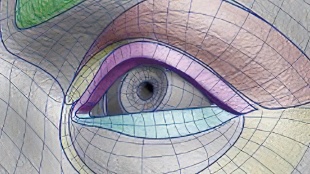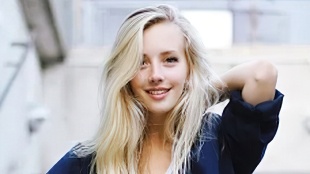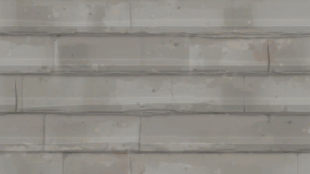您需要 登录 才可以下载或查看,没有账号?注册

x
本帖最后由 肖简 于 2021-12-26 19:05 编辑
Introduction
Hello everyone! I’m Théo Longeac and I’m a 3D environment artist from Paris, France. I have always been passionate about the worlds that some artists manage to create through their illustration and their history. When I moved into the video game industry, I quickly wanted to focus on Environment creation, because it’s a specialty where storytelling and atmosphere are highly important. I’m going to present to you my latest artwork “Asian Garden”.
介绍
大家好!我是 Théo Longeac,是来自法国巴黎的 3D 环境艺术家。 我一直对一些艺术家通过他们的插图和他们的历史设法创造的世界充满热情。当我进入视频游戏行业时,我很快就想专注于环境创造,因为这是一个非常重要的专业,讲故事和氛围。 我将向您展示我的最新作品“亚洲花园”。
First Approach to the Project
For this project, I had in mind to make a rather stylized environment. After looking at several concepts, a lot of Studio Ghibli’s art impressed me. I wanted to convey a soft and soothing atmosphere with a touch of nostalgia in my illustrations. I started by gathering many references, in order to enrich my basic idea by adding many details to get a more realistic rendering that makes the project comes alive. Here, I used several types of references: some quite global photos of Asian houses and gardens, but also some more precise ones on assets I will have to model, like stone lamps for example. I also gathered artwork from different artists in the same style. I used PureRef, which is an excellent software to organize these ideas quickly.
项目的第一件事
对于这个项目,我想创造一个相当风格化的环境。在看了几个概念之后,很多吉卜力工作室的艺术给我留下了深刻的印象。我想在我的插图中传达一种柔和舒缓的氛围,并带有一丝怀旧感。 我首先收集了许多参考资料,以便通过添加许多细节来丰富我的基本想法,以获得更逼真的渲染效果,使项目变得生动。在这里,我使用了几种类型的参考:一些亚洲房屋和花园的全球照片,但也有一些关于我必须建模的资产的更精确的照片,例如石灯。我还收集了来自不同艺术家的相同风格的艺术品。我使用了 PureRef,这是一个很好的软件,可以快速组织这些想法。
Blockout and composition
I started to work directly in UE4, with primitives, a camera and simple lighting. This may be the most important part. After several tests, I found a composition that I liked, a lighting intention, and a camera angle to focus on. In this project, I haven’t necessarily tried to create a complete environment, but rather to focus on 2 or 3 points of view that would give a particular identity to the scene. From this stage, I drew a certain number of specific assets that I would later need to concretize my work.
定型和组合
我开始直接在 UE4 中工作,使用基元、相机和简单的照明。这可能是最重要的部分。经过几次测试,我找到了我喜欢的构图、照明意图和要聚焦的相机角度。在这个项目中,我不一定要尝试创建一个完整的环境,而是专注于为场景赋予特定身份的 2 或 3 个观点。从这个阶段开始,我绘制了一定数量的特定,我以后需要这些资产来具体化我的工作。
Modeling, Integration
Once the desired atmosphere was obtained, I switched to 3Ds Max, in order to start modeling my assets quickly and integrate them in UE. At that step, these assets were not perfect, but they can be retouched and optimized afterwards. The idea was to have a Blocking 2.0, more accurate, and to be able to adjust my camera and lighting on it. At that stage, I had modeled the main assets of my composition: Several parts of the building to assemble, the tree, the rocks and the fence. I tried to model in a modular way, which allowed me to save time and to be able to test several configurations for my scene. For example, I had thought of integrating a small pond, but I finally gave up this idea, because the scene was too busy, and became more difficult to read.
建模、集成
获得所需的氛围后,我切换到 3Ds Max,以便快速开始对我的资产进行建模并将它们集成到 UE 中。在那个阶段,这些资产并不完美,但可以在之后进行修饰和优化。这个想法是有一个更准确的 Blocking 2.0,并且能够调整我的相机和灯光。 在那个阶段,我为我的构图的主要资产建模:要组装的建筑物的几个部分,树木、岩石和围栏。我尝试以模块化方式建模,这让我能够节省时间并能够为我的场景测试多种配置。 比如我曾经想过整合一个小池塘,但最终还是放弃了这个想法,因为场景太忙了,而且变得更难看。
Then I could optimize all the elements that required it. I’d rather delay the optimization because often enough I modified my assets in the previous steps, so it was a waste of time to optimize assets before I was sure to use them. So you have to find the right balance between looking for improvements for the scene, which is always possible, and the need to move forward in the creation of the scene.
然后我可以优化所有需要它的元素。我宁愿延迟优化,因为我在前面的步骤中经常修改我的资产,所以在我确定使用资产之前优化资产是浪费时间。因此,您必须在寻找场景改进(这始终是可能的)与推进场景创建的需要之间找到正确的平衡点。
I gradually started to add texture to my scene. I tried not to touch my composition too much anymore, but I kept on adjusting the elements. I also retouched my camera, in order to have a low angle shot, which seemed more dynamic and made the scene more imposing.
我逐渐开始为我的场景添加纹理。我试着不再过多地接触我的构图,但我一直在调整元素。 我还修饰了我的相机,以便进行低角度拍摄,这看起来更有活力,让场景更有气势。
Then I added the props that would dress my scene and the secondary vegetation. For example, I added some flowers to bring bright colors and contrast with the brown/green already present. 然后我添加了可以装饰我的场景和次要植被的道具。例如,我添加了一些花朵以带来鲜艳的色彩并与已经存在的棕色/绿色形成对比。 Texture
I worked my textures mostly on Substance Painter. Here is an example: I started by applying my base color, then I added a wood texture to create variations in color and shape. Then I added other color variations with a fill layer and an AO. Then I started working on the roughness with several layer blender together. I worked on micro details and increased contrasts. Finally, I lightened the edges to give them an aged look. 材质
我主要在 Substance Painter 上处理我的纹理。 下面是一个例子: 我首先应用我的基色,然后添加了木材纹理以创建颜色和形状的变化。然后我用填充层和 AO 添加了其他颜色变化。然后我开始用几层搅拌器一起研究粗糙度。我研究了微观细节并增加了对比度。 最后,我使边缘变亮,使它们看起来很老。
实际上,我试图通过创建智能材料来尽可能地以程序化的方式工作,我可以在这个项目中使用这些材料,也可以在其他项目中使用这些材料。它让我能够尊重场景中不同材料之间的连贯性(例如建筑物的木材和屏障的木材具有相似的基础)。
I also used substance designer for the texture of the floor. On bigger projects I usually work on designer, but here, as I had quite few assets, I opted for painter, on which I feel freer artistically, and which allowed me to go further in the details I wanted to bring into my assets.
我还使用了 Substance Designer 来设计地板的纹理。在较大的项目中,我通常为设计师工作,但在这里,由于我的资产很少,我选择了画家,在艺术上我感觉更自由,这让我可以在我想带入资产的细节上走得更远。
Final lighting and Post Process.
I tried to keep my lighting as simple and efficient as possible. I started by adjusting the general brightness with an ambient light in UE4, then I added a directional light, in order to find satisfactory light/shadow contrasts. I lightly tinted my lights for an early evening atmosphere which, according to me, is the calmest and warmest moment of the day.
I also used an exponential fog, which I set at the same time as my final lighting. It serves to tinkle my stage and to create a softer atmosphere. I also tried to keep the post process as light as possible, I added vignetting and a bit of grain to start with. I slightly modified the tint and contrast to give a slightly aged side to my image. Then, I added some dust particles and some fake godray. Finally, I could go through photoshop to adjust the last details on my image, it’s was just a step that allowed me to put some finishing touches.
最终照明和后期处理。
我试图让我的照明尽可能简单和高效。我首先在 UE4 中使用环境光调整一般亮度,然后添加了定向光,以找到令人满意的光/影对比度。为了营造傍晚的氛围,我轻轻地给灯光着色,在我看来,这是一天中最平静和最温暖的时刻。
我还使用了指数雾,它与我的最终照明同时设置。它可以使我的舞台叮当作响,并营造出更柔和的氛围。 我还尝试让后期处理尽可能轻松,开始时我添加了渐晕和一点颗粒感。 我稍微修改了色调和对比度,使我的图像略显陈旧。 然后,我添加了一些灰尘颗粒和一些假的godray。 最后,我可以通过 photoshop 调整图像的最后细节,这只是让我进行一些收尾工作的一步。
I have worked on this project for about 3 weeks. It was an iterative process. Looking at it today, I have found some flaws, which will be avenues of improvement for my future work. I was used to ask for feedback from people around me, whether they are familiar with 3d or not, and this allowed me to push it much further, to see my composition from a new angle and especially to check what catches the eye of the neophyte during his first (and often decisive) glance. Here are a few lessons that I’ve learned and that, far from being good practices in their own right, may be able to inspire you in your organization and your achievements: -Set a time limit and do the best you can during this period. I could still spend days improving details,
but you have to know when to finish your project. -The step of looking for references is very important, it is a great source of inspiration that allows you
to flesh out a scene. -It is important not to have too many assets. It is better to look for relevance rather than quantity. -Don’t hesitate to ask for feedbacks, when you work hours on a project, you don’t see some mistakes
that could be avoided. Moreover, it seems important for me to take a step back from time to time on
one’s work, and then come back to it with a new look.
我已经在这个项目上工作了大约 3 周。这是一个反复的过程。 今天看了一下,发现了一些不足,可以作为我以后工作改进的途径。我习惯于向我周围的人征求反馈,无论他们是否熟悉 3d,这让我能够更进一步,从新的角度看待我的作品,尤其是检查什么吸引了新手的眼球在他的第一眼(通常是决定性的)一瞥中。 以下是我学到的一些经验教训,它们本身并不是良好的做法,而是可以在您的组织和成就中激励您: - 设定时间限制并在此期间尽力而为。我仍然可以花几天时间改进细节,
但你必须知道什么时候完成你的项目。 - 寻找参考的步骤非常重要,它是一个很好的灵感来源,可以让你
充实一个场景。 - 重要的是不要拥有太多资产。最好寻找相关性而不是数量。 - 不要犹豫寻求反馈,当你在一个项目上工作时,你看不到一些
可以避免的错误。而且,对我来说,在
工作中时不时地退后一步,然后以新的面貌重新回到工作中似乎很重要。
| 






 评分
评分








